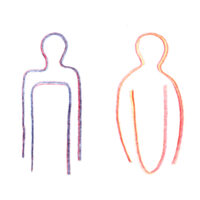Children and young people know early on which gender they identify with. They need attentive guidance that can enable them to lead a healthy and fulfilling life.
As the community has become more open, a lot has changed in terms of how trans people are treated and, in particular, how their rights to self-determination are respected. Increasingly, people of all ages who do not feel they belong in the body with the gender they were assigned at birth (“transgender” or “genderfluidity”) are coming out. This is probably due to improved public awareness and access to information, not to an actual increase in cases. We need to make this topic understandable for those who are not affected by it and learn to deal with it in a respectful way.
Firstly, “differences in sex development” refers to a wide range of characteristics at different levels: chromosomal, gonadal, and phenotypic sex variants. These diagnoses, summarized under “differences (disorders) of sex development” (DSDs), are rare congenital disorders, accounting for less than 5 in 10,000.1 Like transgender people, people with these conditions are significantly impaired in their quality of life until a suitable understanding, diagnosis, and treatment are present.
The psychological characteristics of gender identity must be clearly distinguished from DSDs. Here, the self-perceived identity is in discrepancy to the biologically defined gender assignment. Those affected often do not talk about their gender identity for a long time due to a fear of exclusion, stigmatization, or a lack of knowledge. Incidentally, a person of any gender identity (and also with a DSD) can have a range of sexual orientations (heterosexual, bisexual, homosexual).
Gender affiliation is often felt by children at an early age; parents also notice “a difference” at preschool age, but it is often not until early puberty that words are found for it. The social structure of parents, peer group, friends and partners, school, and cultural/religious background may temporarily influence the self-identifying behavior of children and young people, but not their gender identity in the long term. 2.6–4% of boys and 5–8.3% of girls temporarily behave like the opposite sex, and around 1% of boys and 2.5% of girls temporarily wish they belonged to the opposite sex.2 The figures available are hardly reliable and very imprecise. In my rather large transgender clinic, I have seen considerably more trans men (girls who feel like boys) than trans women (boys who feel like girls) in recent years. The feeling of belonging to another gender can often be understood and confirmed by the parents at first mention. In some cases, it is not possible to assess this immediately, so it is advisable to wait and see. The decisive question for starting hormonal therapy is: how sound is the feeling of being in the wrong body?
Developmental Stages of Gender Affiliation
Today, we proceed on the assumption that a child’s gender identity is formed between the ages of three and five, but that it can still change during the course of further development. By the age of 12 to 16, a child’s final identity and sexual orientation is usually determined, unless the person has met with obstacles due to societal and social morals. There are two problem areas when someone experiences themselves differently from the gender they were assigned at birth: first, the unbearable, subjective feeling of being in the wrong body, and second, the painful lack of understanding on the part of caregivers. The subjective burden usually improves as soon as hormone treatment begins. Depending on the age and stage of development, a hormone blocker is first administered in consultation with those affected, followed by the cross-sex hormone in a second step. Hormonal therapy before or at the beginning of puberty prevents the development of external (undesired) sexual characteristics; later on, treatment is more difficult. Sex reassignment surgery may also follow as a possible third step.
It is important that one clearly and thoroughly inform oneself about surgical methods and experienced clinics, as the result should be satisfactory for life. The diagnostics that precede treatment take into account self-assessment, behavioral observations by the social environment, and in-depth child endocrinological diagnostics with sex hormone and chromosome determination. The latter serves to rule out somatic disorders of sexual development and to assess the risks of hormone therapy. The family is carefully informed about the current state of research and treatment and supported in dealing with uncertainties regarding gender identity development. The therapeutic measures must be preceded by a psychotherapeutic co-assessment; surgical interventions require medical reports and the consent of the health insurance companies. The indication is determined by a unanimous decision of the team along with the family. The open-ended therapeutic discussion aims to achieve the necessary diagnostic certainty and serves to rule out possible differential diagnoses, psychoses, and other psychiatric diagnoses that are significant for and influence the treatment decision. Some affected persons decide to live with the different gender or in their physically prescribed body for the rest of their lives and to endure the discrepancy. Self-determination of their own identity allows them to decide for themselves what feels appropriate.
In Germany, the new Self-Determination Act (Selbstbestimmungsgesetz), valid from November 2024, allows people to freely decide on their gender identity, even in adolescence.3 The family court is responsible for changing civil status and name. A late diagnosis or clarification in the case of gender development especially seems to be a psychological stress factor for those affected, as the ambivalence and lack of authenticity make life more difficult. Human beings have a right to be different. That is why the societal goal today can be to grow from a binary to a non-binary society with gender diversity. In society in general, encounters with trans people are characterized by ambivalent curiosity and controversial attitudes. Transgender people are confronted with conventional-traditional restrictions and moral and ideological hurdles that hinder the free unfolding of an individual. Assumptions that this is a psychological dysfunction—from the perspective of binary gender—persist in many countries.
Rudolf Steiner had progressive ideas for his time. In the anthroposophical view of the human being with physical, etheric, astral bodies, and ‘I’ consciousness, he considered the binary view with opposing genders to be insufficient; instead, one should speak of male and female characteristics.4 Steiner states that gender and its evolution are inextricably linked to the spiritual progress of humanity. Originally hermaphroditic, the development of the sexes helped human beings to form their individuality by enabling them to perceive the self and the other. Today, as we move away from the binary framework of gender, we are viewing human gender on a continuum and moving towards greater individual freedom and an understanding of universal human experiences undetermined by gender.5

Social Aspects of Gender Identity Development
Children and adolescents who visit an endocrinologist or psychologist for the first time with questions about gender identity often have stressful social experiences. Thanks to the opportunities offered by the media, they have been able to find out more about the topic and even make contact with other affected people. In their everyday lives, they have to deal with basic questions such as whether a gender-neutral toilet in schools would be a simple but very helpful support. It is exciting for developing young people to find the time to talk about this with their parents, friends, and teachers. This is easier and more likely to succeed when there is less pressure from the environment or when there are other people with the same orientation. The assumption that some people make this decision because of the attention they receive is virtually impossible to verify. Only 1–2% of gender reassignments are reversed in the following years.6
For those affected, the tension between their own experience of their body, their external image, and their desire to be themselves remains a lifelong process of discovering their identity. During this delicate phase, young people need sensitive, attentive support and acceptance of their gender identity in order to prepare them for a life as healthy, unique human beings. This includes professional caregivers adopting gender-sensitive language. The planned new S3 guideline on gender dysphoria for children and adolescents, which is expected to be completed in 2024, is associated with a paradigm shift in the sense of destigmatizing those affected.7 The concepts of “gender incongruence” and “gender dysphoria” are no longer understood as a mental illness, but gender dysphoria maintains clinical significance as a subjective condition. Today, this is already a fixed standard in specialized professional circles. The previously necessary “everyday test” and year of psychotherapy are no longer required.
In many countries, the psychopathologization of this phenomenon has been giving way to depathologization for years. This makes it easier for those affected to see that external and internal perceptions increasingly coincide with their developmental process. The aim of transformation treatment is sustainable psychological and somatic health. This requires destigmatization within society. It is important for parents to understand that they cannot change their child’s feelings—because these are already formed in the first years of life. The risk for them is that they may lose touch with their child. The guideline-based treatment approach today is: “Say how you want to be; Be it; And, what help do you need to do this?”
Translation Joshua Kelberman
Footnotes
- U. Thyen, K. Lanz, P. M. Holterhus, O. Hiort, “Epidemiology and Initial Management of Ambiguous Genitalia at Birth in Germany,” Hormone Research in Paediatrics 66, no. 4 (2006): 195–203, doi: 10.1159/000094782.
- K. J. Zucker, R. Green, S. Coates, B. Zuger, et al, “Sibling Sex Ratio of Boys with Gender Identity Disorder,” Journal of Child Psychology and Psychiatry 38, no. 5 (Jul. 1997): 543–51, doi: 10.1111/j.1469-7610.1997.tb01541.x; F. C. Verhulst, J. van der Ende, “Factors Associated with Child Mental Health Service Use in the Community,” Journal of the American Academy of Child and Adolescent Psychiatry 36, no. 7 (Jul. 1997):901–09, doi: 10.1097/00004583-199707000-00011.
- “Gesetz über die Selbstbestimmung in Bezug auf den Geschlechtseintrag und zur Änderung weiterer Vorschriften” [Act on Self-Determination with Regard to Gender Entry and Amending other Provisions] Deutscher Bundestag: Dokumentations- und Informationssystem für Parlamentsmaterialien [German Parliament: Documentation and Information System for Parliamentary Materials]
- Cf. Rudolf Steiner, Cosmic Memory: The Story of Atlantis, Lemuria, and the Division of the Sexes, CW 11 (Great Barrington, MA: SteinerBooks, 1987), Ch. 6, “The Division of the Sexes.
- Jack Palmer, “Understanding and Educating Transgender Youth in the Waldorf School,” Waldorf Resources (Jan. 13, 2020).
- Bernd Meyenburg, Geschlechtsdysphorie im Kindes und Jugendalter [Gender Dysphoria in Childhood and Adolescence] (Stuttgart: Kohlhammer, 2020).
- Arbeitsgemeinschaft der wissenschaftlich-medizinischen Fachgesellschaften (AWMF) [Association of the Scientific Medical Societies in Germany], S2k-Leitlinie Geschlechtsinkongruenz und Geschlechtsdysphorie im Kindes- und Jugendalter: Diagnostik und Behandlung [S2k Guideline for Gender Incongruence and Gender Dysphoria in Childhood and Adolescence: Diagnosis and Treatment], register number 028-014 (submitted Dec. 16, 2023, review not yet completed).









